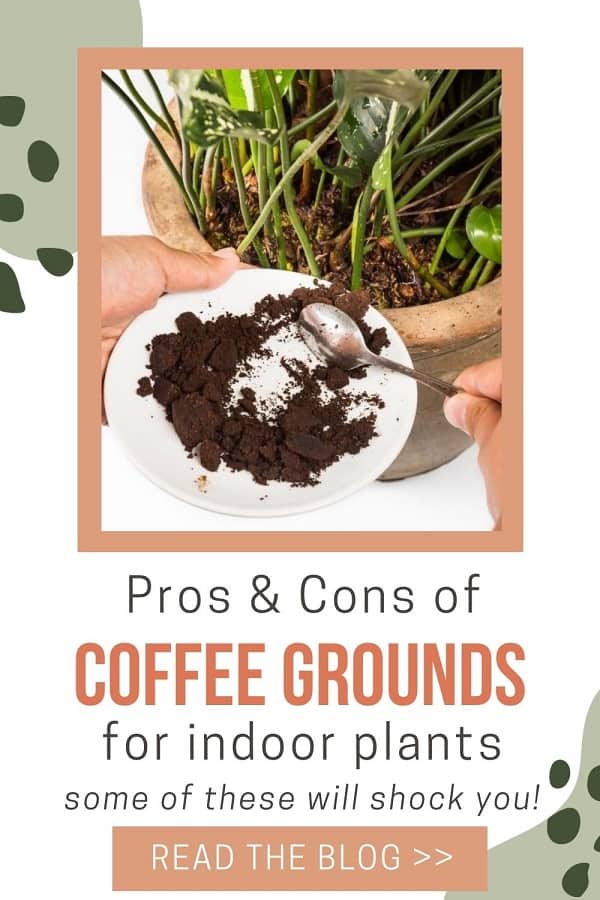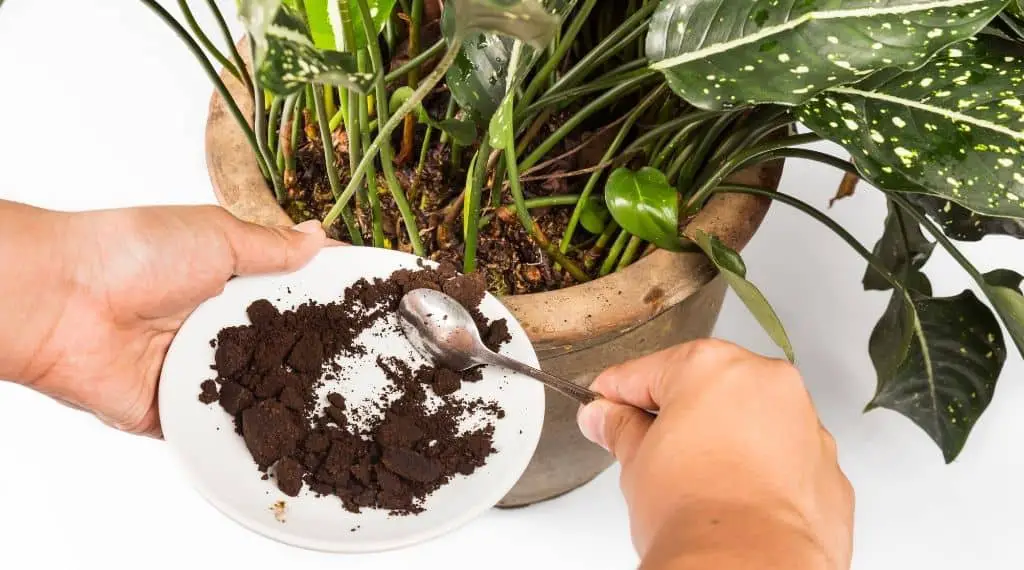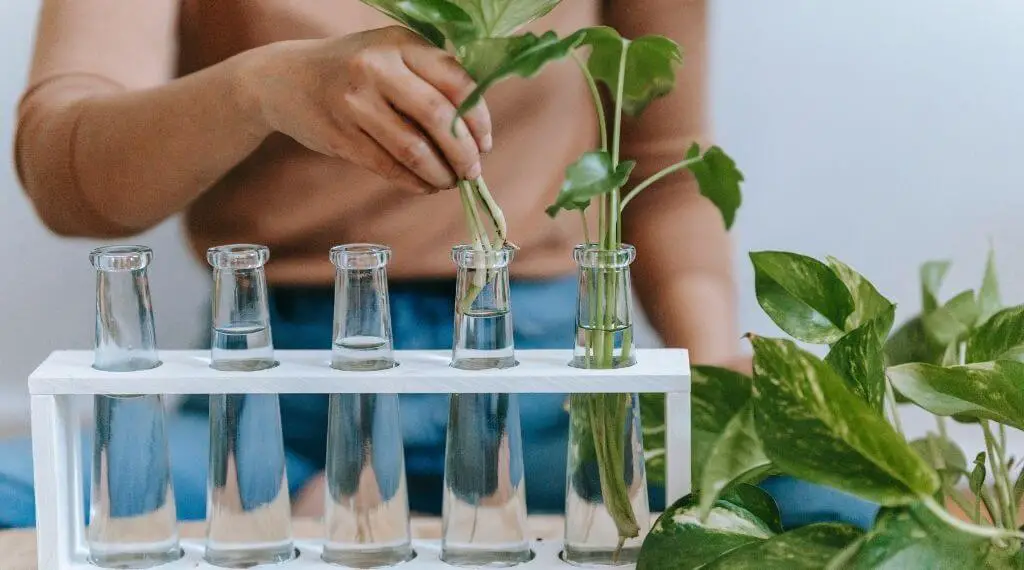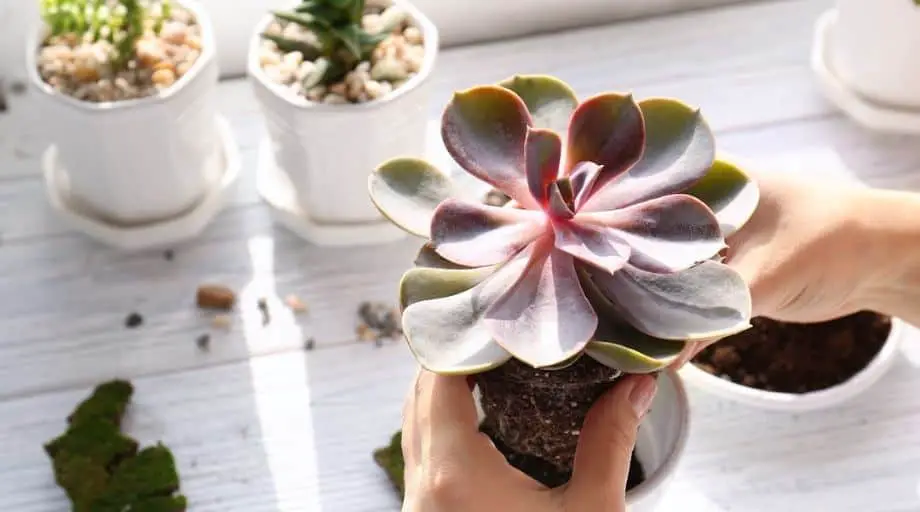Last Updated on October 5, 2021 by Plantiful Interiors
Whether you’re new to growing houseplants or are a seasoned houseplant hobbyist, when learning about how to keep your plants healthy, you may have read about a little trick using coffee grounds.
But, are coffee grounds good for houseplants?
The simple answer is yes coffee grounds are good for houseplants but only certain ones. Some houseplants do not like coffee grounds at all, while others eat them up (literally).
Coffee grounds provide many benefits to ensuring that your house plants grow and remain healthy but are more commonly used in outdoor gardens.
With an influx in new plant parents, I’ve seen more and more people asking if coffee grounds are good for houseplants. We’ve researched the topic quite a bit and will share with you what we’ve found out about how coffee grounds help plants and how to use coffee grounds in potted plants.
This site features affiliate content. As an affiliate partner of various brands, we earn commissions on qualifying purchases, at no extra cost to you. Please read our disclaimer for more information.
You can click any of the topics above to skip directly to that section, but we highly recommend that you browse the entire article so you can make an educated decision on whether or not to use coffee grounds on your indoor plants.
Benefits of Adding Coffee Grounds To Houseplants:
There are three main benefits of adding coffee grounds to houseplants:
- Serve as extra organic matter
- Contain nutrients plants need
- They deter pests
If you’re a regular coffee drinker and a plant parent, start saving your coffee grounds. These are a great resource of organic matter.
Before we dive into the benefits of adding coffee grounds to your house plants, let’s first take a look at the major nutrients that are present in coffee grounds:
- Nitrogen
- Phosphorous
- Potassium
- Magnesium
- Copper
- Manganese
- Calcium
- Iron
- Zinc
The presence of these nutrients in coffee grounds show that if used correctly, coffee grounds can supply your soil with almost the same nutrients as you would get from regular fertilizer.
There is however a downside to using coffee grounds in replace of fertilizer and that is that the nitrogen in coffee grounds isn’t as readily available to your houseplants. Instead, they act as a slow-release fertilizer so it takes longer for the nutrients to be released and absorbed by your plants compared to a regular fertilizer. This isn’t necessarily a bad thing, as you’ll see as you read on, but it’s important to note that you won’t see overnight improvements in the health and growth of your plants.
That being said, there are many other benefits of using coffee grounds in potted plants.
They Serve As Extra Organic Matter in Compost
You can add coffee grounds to your houseplants by mixing them with an organic compost before adding them to your soil. This is most easily done when you are repotting a plant or adding fresh potting mix.
You can purchase organic compost (that doesn’t smell and is great for house plants) from your local nursery or home improvement store.
When you mix your coffee grounds with the compost, the coffee grounds provide extra organic matter to the compost and can speed up the decomposition of compost.
The decomposition process is sped up because the coffee grounds encourage the growth and reproduction of microorganisms in the soil. These microorganisms then break down the coffee grounds and provide nutrients to your plant.
The microorganisms do not only break down the coffee grounds and consume them, but over time they also deposit the coffee grounds deep into the soil, and in doing so the roots of the soil get the maximum nutrients offered by the compost and coffee grounds.
It’s important to note that even though the nitrogen present in coffee grounds may take a few days to break down, the nitrogen present can still serve as green matter to the soil.
As the microorganisms break down the coffee grounds, the nitrogen is released into the soil. The slow release of nitrogen into the soil isn’t a bad thing, your plants will still grow and flourish given that you apply the coffee grounds the right way, just don’t expect any overnight miracles
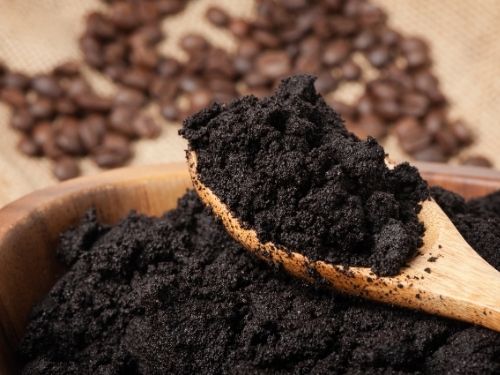
Coffee Grounds Improve Soil Quality and Are Good Fertilizers
Using coffee grounds as a fertilizer in your houseplants is a great way to improve drainage and aeration in the soil.
Fresh coffee grounds are more acidic than brewed coffee grounds however and contain a higher level of caffeine. Because of the high level of caffeine in fresh coffee grounds, it is not recommended to use these if you have pets in the house as caffeine can be toxic to animals.
Houseplants such as African Violets and Jade plants can make good use of coffee grounds as their nutrient source or fertilizer. This is because they are acid-loving plants, and coffee has the right PH and nutrients combination to act as a fertilizer to these plants.
As mentioned earlier, coffee grounds contain nitrogen, phosphorus, and potassium, all nutrients that plants need to survive.
In fact, plants actually require a high level of nitrogen to survive. Coffee grounds have an NPK of 2.1: 0.3: 0.3, which is a good ratio for house plants.
Keep in mind though that it will take time for your coffee grounds to decompose, which means that nutrients are not released immediately.
Use Coffee Grounds in Indoor Potted Plants To Deter Pests
Certain pests such as slugs and snails are less likely to be found in indoor plants but, depending on the type of soil your plant was potted in you may be exposed to some annoying pests that are killing your houseplants.
If you’re having a difficult time with pests in your houseplants, then you might want to try coffee grounds.
While the smell of coffee grounds may sound pleasing to most people, some pests such as snails, red ants, slugs, and many others find the taste and smell of coffee grounds unpleasant. So, do not be scared to sprinkle some coffee grounds over your plants if you want to keep these pests away. Just don’t add a thick layer or you could be susceptible to growing fungus.
Remember, since coffee grounds are acidic, depending on the plant you have, you may choose to balance the acidity of the coffee grounds with some shredded leaves, or ash to make it less acidic for your plants.
How To Add Coffee Grounds to Houseplants
As we have described above, coffee grounds are acidic, and they can make the soil too acidic for some houseplants.
If you decide to test out if coffee grounds will help your plant’s growth, make sure to monitor your soil’s pH level after introducing coffee grounds.
Knowing how to properly apply coffee grounds to the soil will also help reduce the likelihood of damaging your plants.
When people first decide to try coffee grounds, usually the first question they have is: how often should I add coffee grounds to indoor plants?
Coffee grounds should be used in moderation and should not be applied to your indoor plants any more than every 4 weeks.
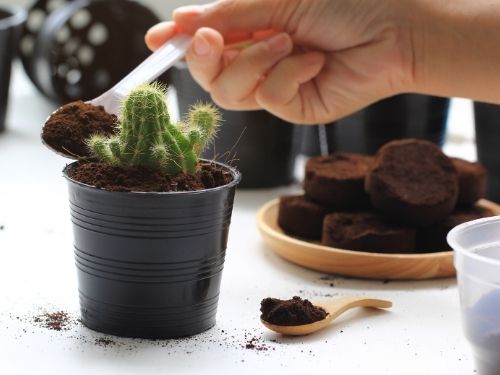
Here are 3 ways you can add coffee grounds to houseplants:
1) Apply Coffee Grounds On Top Of Your Soil
You can place your coffee grounds directly on the top of your soil, similar to what you would do with mulch.
To do this:
- Allow your used coffee grounds to dry out
- Sprinkle a thin layer around your plant
By allowing your coffee grounds to dry out first they will be easier to spread out and less likely to clump.
If the grounds you apply are too thick, you increase the risk of the coffee grounds producing a layer of mould. Although not necessarily damaging to your plant, this will create an unpleasant look and could pose a risk to your own health.
Using dried coffee grounds will make it easier to absorb fresh water and create good aeration.
Another reason for using small amounts of coffee grounds is because the grounds can still have traces of caffeine in them which can deter the growth of your plants. So, you want to spread them lightly.
Our research has shown that if you were to bury the fresh coffee grounds directly into the soil, microbes would then feed on the nitrogen currently present in the soil while breaking down the coffee grounds, so your plant would not be getting as much nitrogen as it may need.
Instead, it would have to wait until the nitrogen present in the coffee grounds is released, which we mentioned earlier takes time. Your plant typically needs a lot of nitrogen so you don’t want to do anything that would reduce the absorption of nitrogen.
Lightly adding the grounds to the top of your soil will not tie up nitrogen to the root zone.
2) Create Your Own Liquid Fertilizer
Seeing someone toss their cold coffee into a plant can have you questing if that was a good idea. But don’t worry, as mentioned earlier the nutrients in coffee are actually good for some common houseplants such as jade plants and philodendrons. But, if you like to add cream, milk, or sugar to your coffee, do not toss this in with your plants.
Although it’s easy to just toss in those last few mouthfuls, you’re better off creating a liquid fertilizer specifically for your houseplants.
Liquid fertilizer is one of the most effective ways to supply the nutrients present in ground coffee to your indoor plants.
This is because with liquid fertilizers the nutrients penetrate the soil easily while also supplying the plant with water.
To prepare a liquid fertilizer out of your coffee, follow the step below:
- Pour your coffee grounds into a bottle or a bowl with a seal
- Add about three glasses of water to the ground coffee
- This should create a 1:3 ratio of coffee grounds to water
- Close the seal and keep it in a cool dry place for three days to allow the water to completely absorb the nutrients
- Once the three day period concludes, filter the water from the coffee grounds
- Pour the filtered water into a spray bottle, and then spray your plant’s soil with the water
Your house plants will not only benefit from the watering, but they will also soak up the same nutrients as if you created a layer of coffee grounds directly around your plant. You can also spray this directly on the leaves and stems of your plant.
3) Add Coffee Grounds To Compost
As we pointed out earlier, coffee grounds contain many nutrients that are beneficial to plants. But, rather than mixing coffee grounds directly in with your soil, add them to your compost first.
Whether you buy organic compost from your local nursery or home improvement store or have your own compost pile you use on your houseplants, adding your coffee grounds can be beneficial.
Mixing compost with potting soil could help combat nutrient deficiencies in some potting mixes.
- Toss your brewed coffee grounds into compost pile
- Mix thoroughly when ready to use
- Add to potting soil in a 1:1 ratio
- Mix thoroughly
The additional organic matter will benefit your plants. Because the coffee grounds are being mixed with other compost items, it eliminates many of the concerns about over-acidity levels and caffeine levels.
Houseplants That Like Coffee Grounds:
- African Violet
- Peace Lilies
- Cyclamen
- Jade
- Philodendron
- Christmas Cactus
Houseplants That Hate Coffee Grounds:
- Rosemary
- Tomatoes
- Lavender
- Pothos
- Orchids
Cons of Adding Coffee Grounds to Houseplants
High levels of caffeine could stunt growth: As we all know coffee contains caffeine, and if the grounds you are adding to your soil– especially when you are directly broadcasting the grounds to the soil– contains high levels of caffeine, it can stunt the growth of your plants. This is because when absorbed into the plant, the caffeine destroys the growth cells therefore preventing the plant from growing. Use coffee grounds in moderation and monitor the growth of your plant.
High level of acidity could throw off the pH level in soil: Monitor the pH level of your plant’s soil using a 3 in 1 soil pH and moisture meter. Fresh (unbrewed) coffee grounds are more acidic compared to brewed coffee grounds so depending on the method you’re using the soil may become too acidic which can damage plants instead of helping them. Watch for yellowing leaves.
Coffee grounds retain moisture: Due to their sponge-like structure, brewed coffee grounds are very good at retaining moisture thanks to their organic nature. This could cause your plant’s soil to become too wet which could lead to root rot. Use a more coarse potting mix and monitor the moisture level so you do not overwater.
Dangerous to pets: Coffee grounds contain caffeine which can be highly toxic to pets. It is advised that if you have pets in the home that can get into your plants, err on the side of caution and avoid using coffee grounds in your plants.
Do Your Research Before Adding Coffee Grounds To Houseplants
We’ve provided you an overview of the research we’ve done on this topic. But, personally, I have not used coffee grounds in my own houseplants as I’m just not sure that the benefits outweigh the possibility of doing damage to my already healthy plants.
When deciding if coffee grounds are something you want to start including in your regular plant care routine, be sure to weigh the pros and cons and definitely research whether or not you have acidic loving plants.
If you’ve experimented with adding coffee grounds to your houseplants, I’d love to hear your results and which plants you used them on. Drop a comment below and let us know if they were helpful or hurtful.
New to plant parenthood? Check out these helpful articles:
Must Have Indoor Plant Care Tools To Keep House Plants Alive
Low Maintenance Indoor Plants for Beginners (Hard To Kill Plants)
How To Choose Best Plants For Apartment Living
